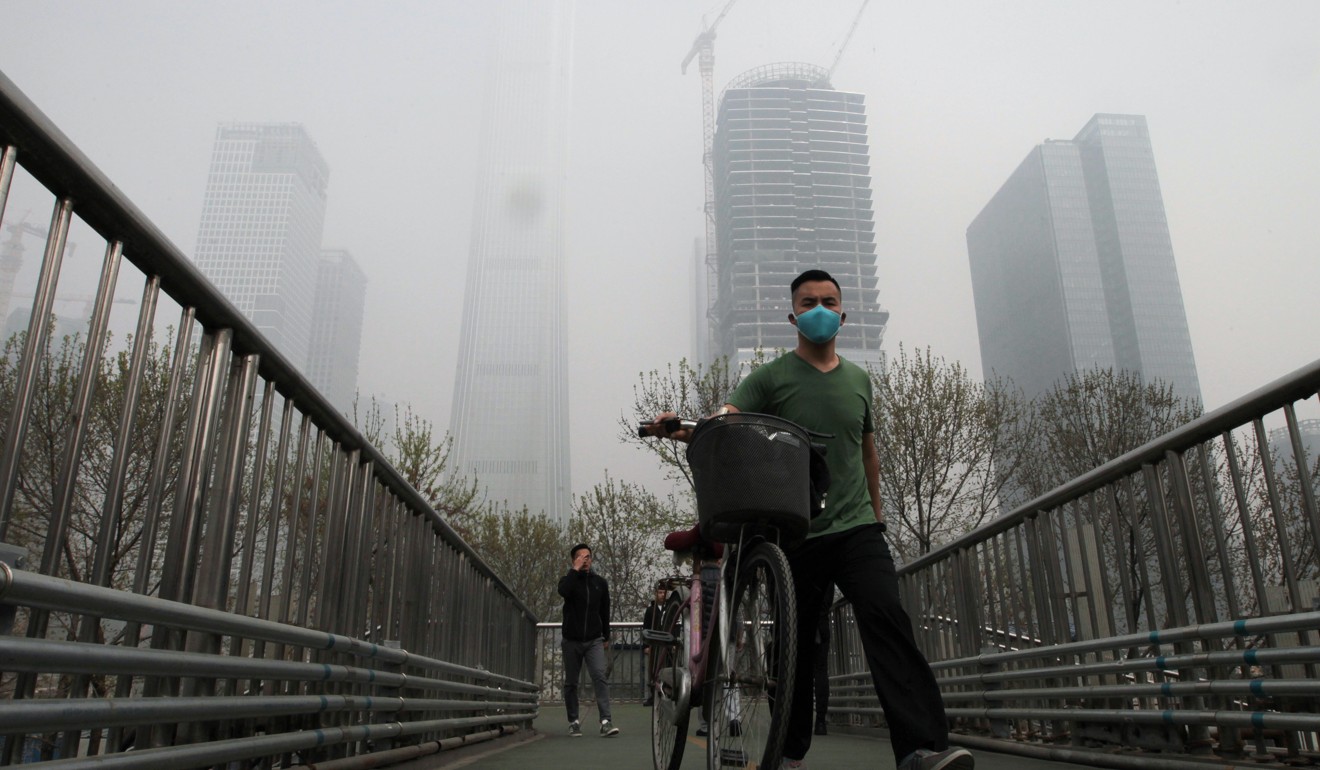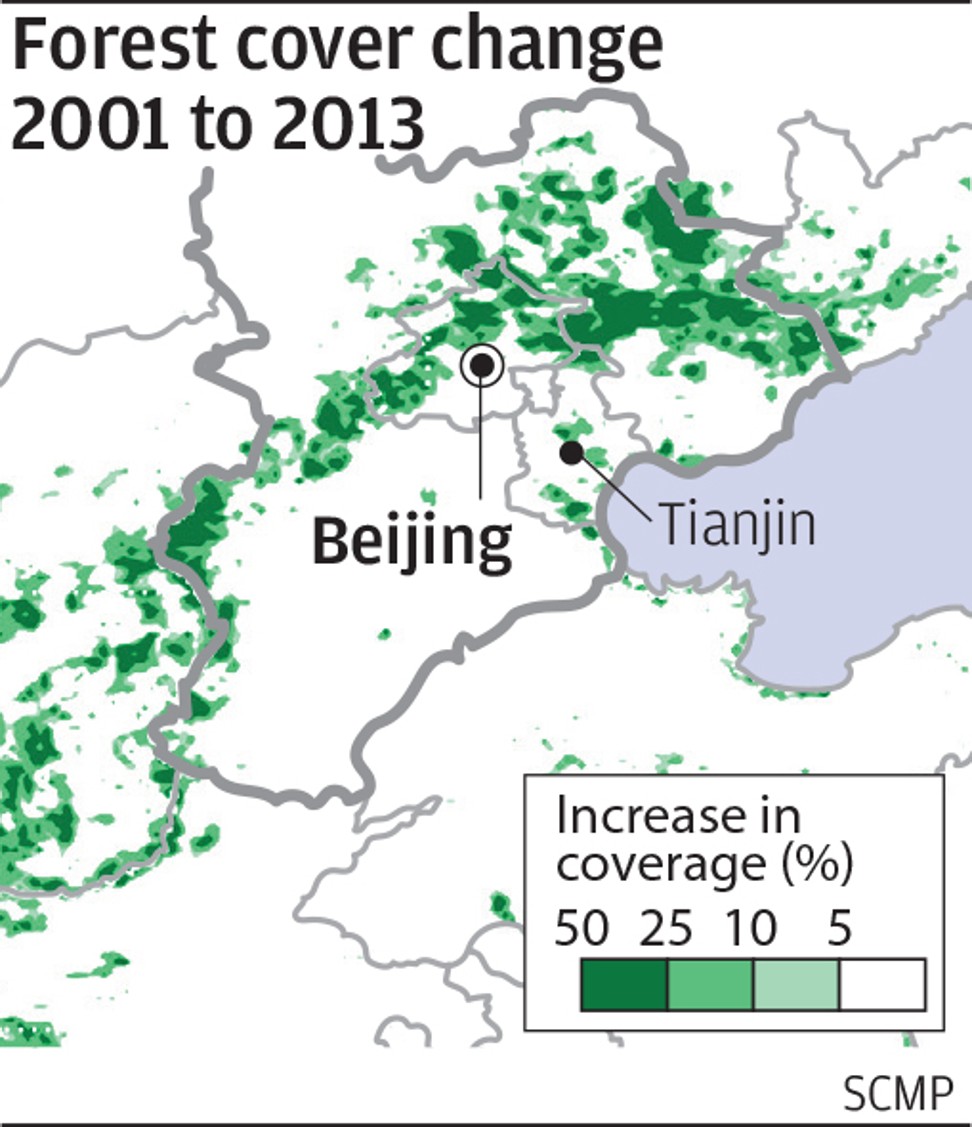
More trees, more smog? How Beijing’s huge planting campaign may be trapping pollution
Extra drag from man-made forest caused concentration of air pollutants to rise by as much as 15 per cent, new study suggests
Beijing’s massive tree planting campaign has worsened air pollution in the city, a new study by Chinese scientists suggests.
The “Green Great Wall” prevented dispersion of as much as 15 per cent of PM2.5 – health-damaging fine particulates less than 2.5 micrometres in diameter – during a major smog episode in the capital in January 2014, according to researchers.
At its peak during the period studied, the PM2.5 reached 350 micrograms per cubic metre of air – 14 times the safety level recommended by the World Health Organisation.
Man-made forest slowed down the winds that otherwise help to disperse smog and turned the city into an enormous trap for air pollutants, according to the scientists.
The relationship between tree planting and smog has been debated for years. The Chinese government has repeatedly denied its tree plantation campaigns have contributed to an increase of smog in Beijing and nearby regions, although “more trees, more smog” has become a popular saying among residents.
The study – the first so far to support a link – was jointly conducted by researchers from the Institute of Earth Environment at the Chinese Academy of Sciences in Xian, the Joint Centre for Global Change Studies in Beijing, and the National Centre for Atmospheric Research in Colorado in the United States.
Their paper was published in Atmospheric Chemistry and Physics, an open-access peer-reviewed journal, early this month.
Overall, man-made forest can be blamed for up to 6 per cent of the air pollutant increase in the entire 218,000 sq km area studied in north China, the authors said.
Compared with other factors such as automobile emission, “the afforestation plays only a marginal role in worsening the haze pollution and does not constitute the main cause of the heavy haze formation”, they wrote.
But the impact could grow to 15 per cent if remaining unplanted areas were to be filled by trees, according to the researchers’ computer simulation.
The researchers analysed landscape change over northern China using satellite data from the early 2000s. The area – consisting of Beijing and the nearby province of Hebei and port city of Tianjin – suffers some of the worst air pollution in China, especially in winter when people used heating.
In nearly all areas, natural shrub and grassland were disappearing, while forests were advancing aggressively.
“The land cover change, particularly the evident forest growth, is primarily attributed to China’s national afforestation programmes aiming to increase the forest coverage and to conserve soil and water,” they wrote in the paper.
China has been conducting what the United Nations has said is the world’s largest tree planting crusade, which increased its forest coverage from 8.6 per cent in 1949 to 21.7 per cent last year.
By March this year, the total area covered by China’s artificial forests reached 69.3 million hectares, larger than the size of France, according to the State Forestry Administration.
Some trees were planted on terrain where they would not have grown naturally, such as steppe, desert and high mountains.
This year the government plans to create another 84,000 sq km of new forests, about the size of Ireland. A regiment of 60,000 soldiers of the People’s Liberation Army is tasked with planting trees in areas north of Beijing, according to state media reports.
Several studies in recent years have suggested that trees could remove ozone, nitric oxides, sulphur dioxide and PM2.5 from the lower atmosphere, with their leaves working as an air filter.
In the new study, the researchers used mathematical models to simulate the effect of trees on smog dispersion. The impact is negligible if winds are strong. But since the 1980s, due to a temperature rise in the Arctic, winds in China from the north have become weaker, according to numerous studies.

This meant that the drag produced by forests became “appreciable”, according to the new study.
During the smog of 2014, northerly winds were not strong enough to reach further south after coming down from the highlands in the province of Inner Mongolia.
“Intensified northerly wind cleanses the northern BTH (Beijing, Tianjin and Hebei), but the haze pollution is still very severe in the southern BTH. The afforestation considerably elevates the PM2.5 concentration in southeastern BTH, particularly in Beijing and Tianjin, with the PM2.5 contribution exceeding up to 15 per cent [in those areas],” they wrote.
“We are not allowed to speak to media (about the paper) without authorisation,” said one researcher involved in the new study, who refused to be named due to the sensitivity of the matter. “I don’t think we will get a nod from the top.”
The forestry affairs ministry did not respond to the South China Morning Post’s queries about the latest study.
“The increase of forest vegetation is conducive to reducing soil erosion and surface dust release, which will decrease the content of dust particles in the atmosphere at a certain level, and weaken the conditions of smog formation,” said Zhang Yongli, deputy minister of forestry affairs in a press conference in 2015.
Jiang Jingkun, professor at the School of Environment at Tsinghua University, and deputy director of the State Key Joint Laboratory of Environment Simulation and Pollution Control, a major smog research lab, said whether or not the government should plant trees on grassland and other areas where they did not grow naturally is a sophisticated issue requiring thorough scientific investigation.
But he said forests would not be chopped down to relieve air pollution.
“The trees are planted for many reasons, related to the overall well-being of the environment and people’s living standard,” he said. “Cooking also produces some air pollutants, but we can’t ask people not to cook.
“There are many technical and engineering solutions to address the air pollution issue. We don’t need to hit the rewind button.”


